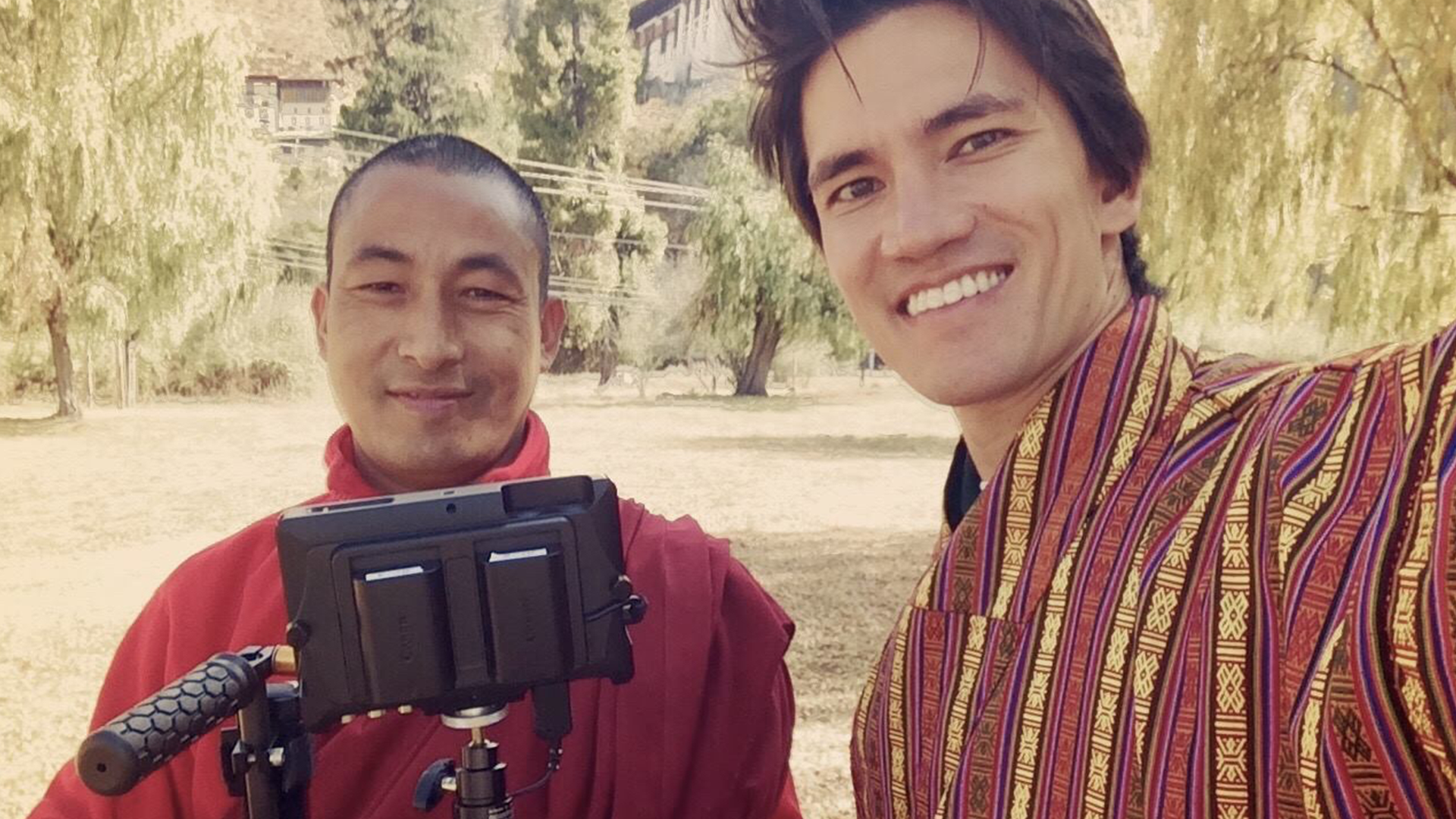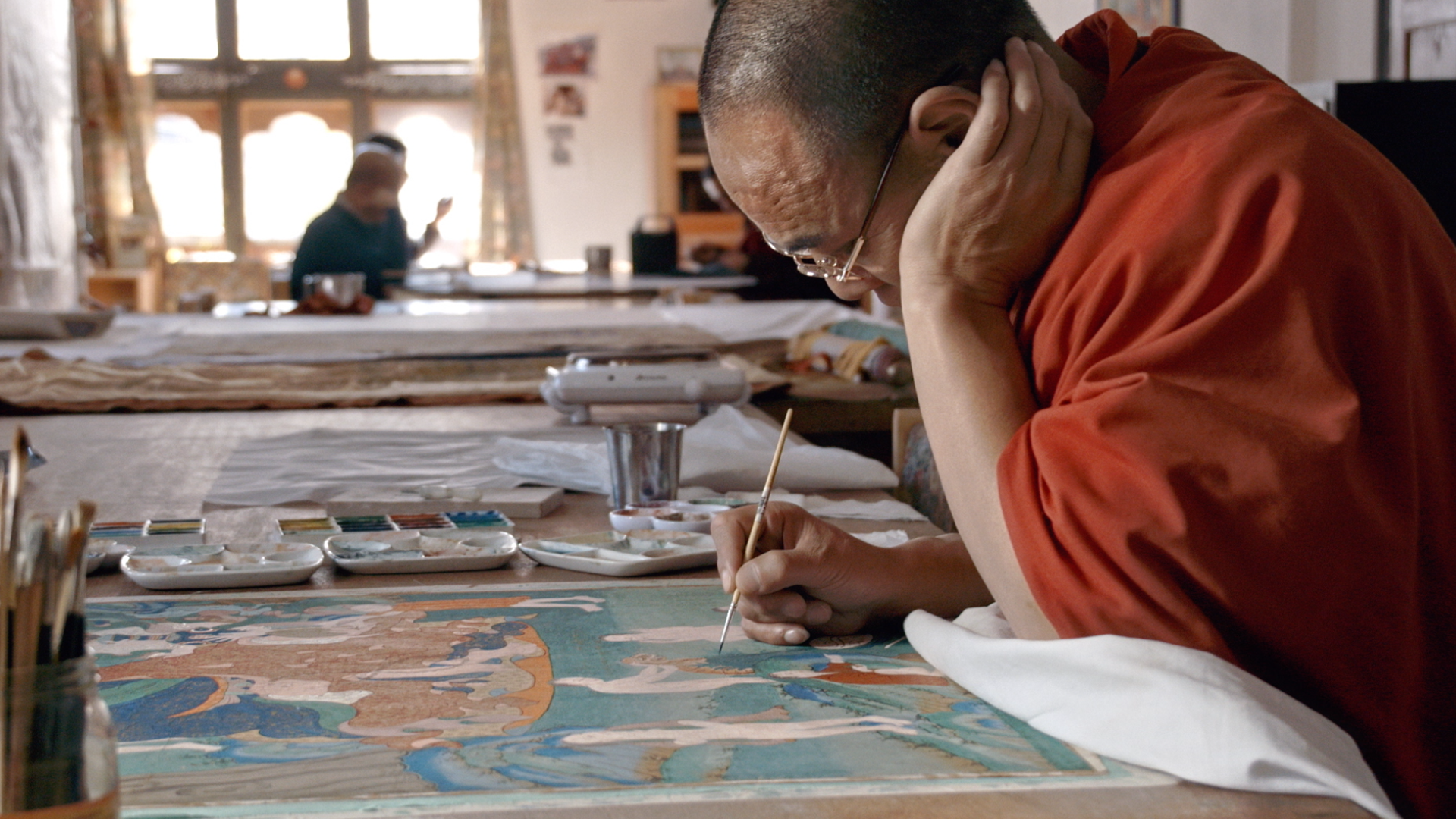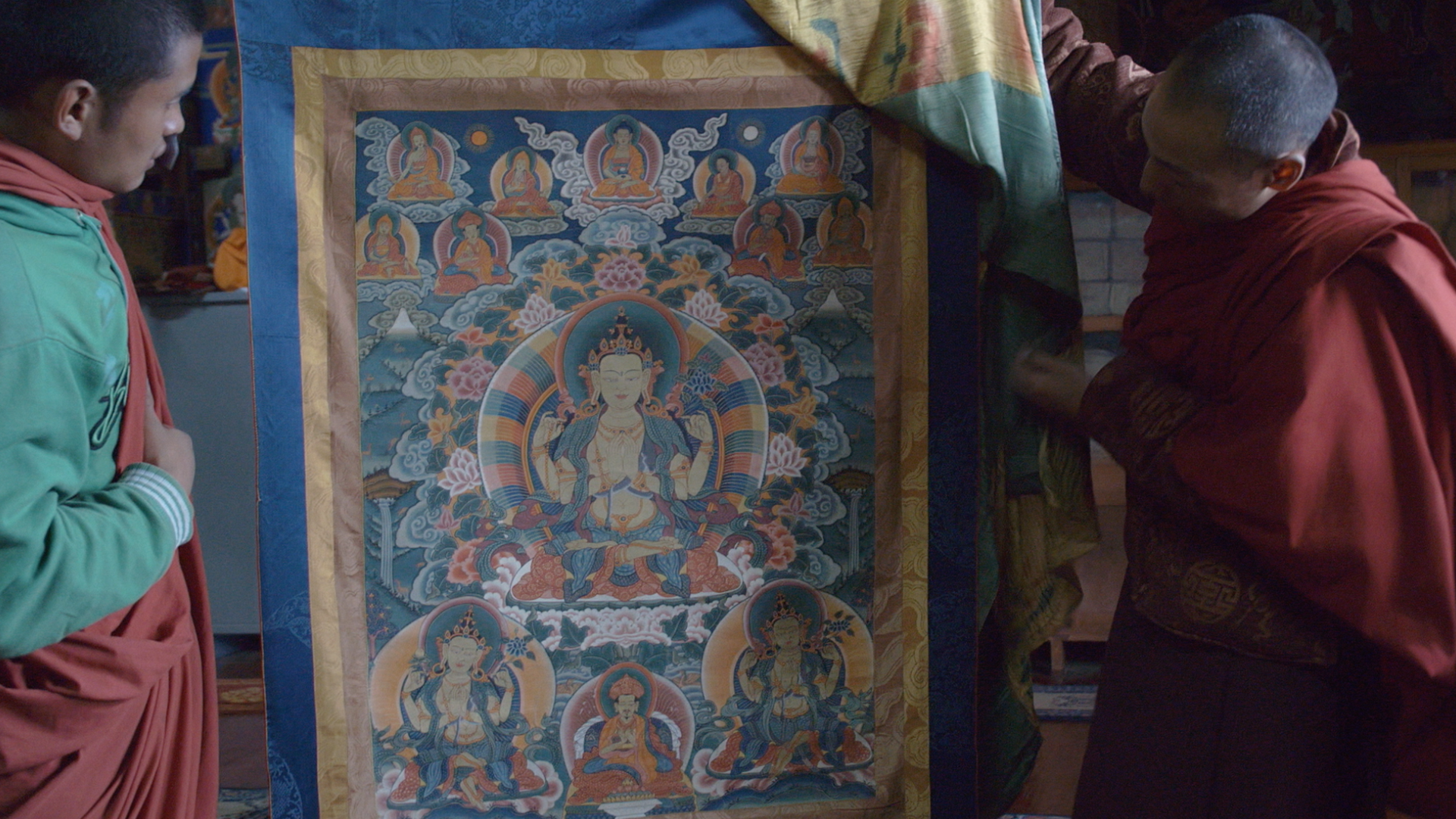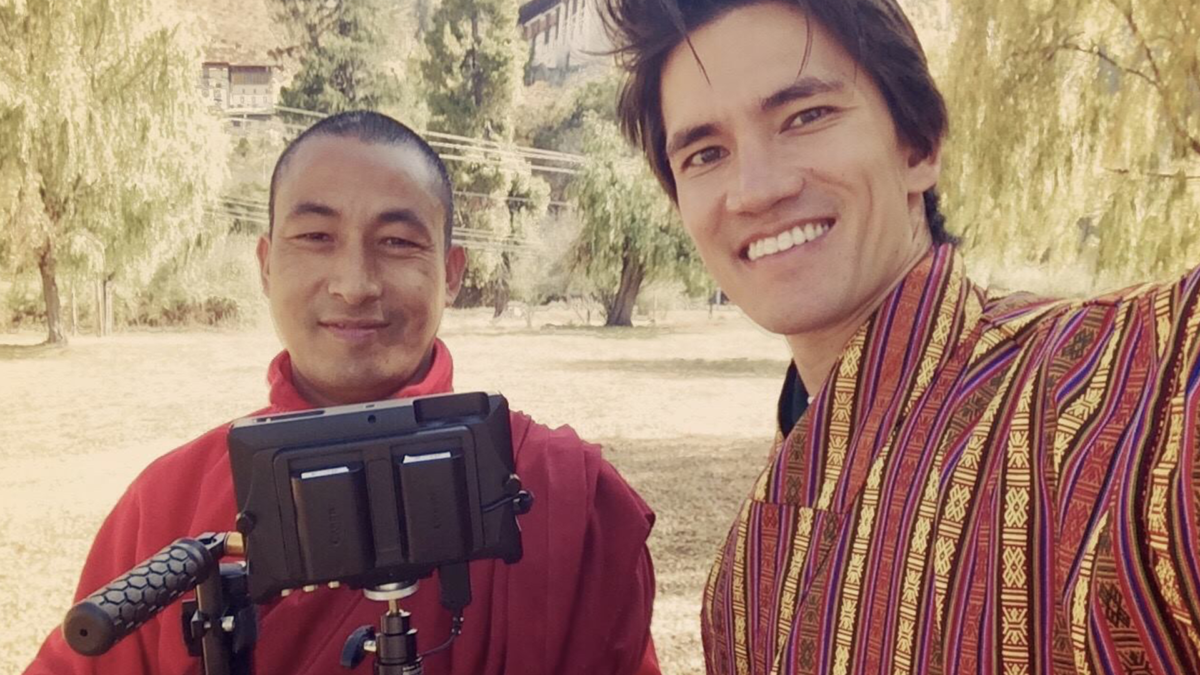The Kingdom of Bhutan is the only remaining Vajrayana Buddhist country in the world at present. What sets them apart from other Buddhists across Asia is their incorporation of the thangka, intricately painted scrolls, in meditation. This art form is an integral part of Bhutanese culture, but there aren’t many artists today that can properly preserve them and/or recreate them. The documentary 1000 HANDS OF THE GURU tells the story of a conservation art master, a couple of monks, and a princess, who team up to save this dying cultural cornerstone.
Cinevue sat down with Tobias Reeuwijk–writer, director, and producer of 1000 HANDS OF THE GURU–to learn more about the film.

Alexa Strabuk: Can you talk a little bit about how you personally became involved with Eddie, the monks, and the thangka? How did you know this was happening?
Tobias Reeuwijk: Sure. So I first became aware of the whole project when [the monks and Eddie] were in Hawaii for their exhibition. They came to paint a bunch of surfboards. I was not into Buddhist art at all so when I saw the surfboards, I thought it was such a cool blend of art—Himalayan art—and surfing. I went to the exhibition and met the monks and Eddie for the first time, and then, something like three years later, Eddie reached out to me and asked if I’d do a short video for them.
AS: Very cool.
TR: I signed up right away. I was like, “I’m down, I’m all in,” and from there, it turned into a longer project, rather than just doing a short three-minute video.
AS: Wow, I had no idea it was supposed to be that short.
TR: In the beginning, I thought we were going to go in there for two weeks to shoot this short video. It was supposed to be just a simple, how-to on taking care of your thangka for the monastic body. So originally, I didn’t even think I was going to shoot a documentary, I thought we were just going to be in and out.
But after a few talks with Eddie, and Princess Ashi Kesang, we decided that it would behoove us to tell the greater story. The vision, the whole story, was constantly unfolding. It was actually tough to keep up. There was no grand vision, I just knew that I wanted to show the struggle of the monks and the princess, and how they’re making an impact in Bhutanese society today.
AS: I think you definitely succeeded there. The film is beautiful.
TR: Thank you.
AS: So what was your timeline like, then? What year did they visit Hawaii and when did you begin filming?
TR: They came to Hawaii in 2008, I think, and then in 2011… actually I think it might have been 2009. I’m getting my dates mixed up. [laughs] We delayed shooting for about a year because we couldn’t get permits. The first year was in 2013 in October. We went three times: once in 2013, the same time the next year in October, and then this year, we went very early to film some pickup shots.
AS: And for how long were you there at a given time?
TR: About fourteen days.
AS: What was it specifically that was so compelling to you about this story?
TR: Well, for one, I was fascinated by Buddhist art, and I was kind of on a Buddhist philosophy binge. The whole idea of letting go and contemplation, that inner journey, was really, really fascinating to me. When I came across these four monks, dedicating their lives to practice these values of compassion, I liked the idea of finding that within yourself.
There’s a sense of letting go throughout the whole project, because for one, [the monks] are trying to save the artworks, but at the same time, there are many losses that they have to go through, too. You can’t save them all, right? It’s a nice metaphor for dealing with the trials and tribulations that everyone faces in their daily lives.
AS: Did you ever get an opportunity to participate in the actual preservation process or were you just documenting it?
TR: No, I definitely stayed away from any of the preservation stuff. You need training. They do training in painting first, with perspective, and then they do oil paints and drawing classes as well. You need a pretty solid background before you start doing some of the finer preservation. That’s the destination. So I definitely learned a lot, but no, I never picked up the brush.

AS: You mentioned this project spanned three years—which is a pretty significant chunk of time. Can you talk a little bit about what that process was like?
TR: Yeah…we shot a lot. Two weeks, we just kept the camera rolling nonstop. At first, it was hard to find the core story because there was so much going on. But as I developed a relationship with the monks and the princess, they told me a lot more. It’s that process of building trust.
AS: As a documentarian, since you’re not necessarily directly related to what’s going on in Bhutan right now, how do you make sure to portray your subjects and these topics authentically?
TR: I always tried to check in with Princess Ashi Kesang [of Bhutan] when we had a new cut. I had a good dialogue with her, so she’d give me comments and I’d ask a ton of questions. We were messaging and WeChatting every other day.
I’ve learned with documentaries, that even camera placement—something as seemingly trivial as that—you’re inevitably going to put your subjective, abstract sense of who you are into the story. So staying objective has been a challenge, especially with art conservation.
AS: What’s challenging about it?
TR: It’s tempting to try to dramatize what the actual story is. But I would say patience was the best lesson in terms of finding the real story. That’s the part where everyone definitely put in the most, it wasn’t so much financial, it was mostly putting in the time to really talk and dialogue. That’s what led to the genuine moments.
AS: Did the princess give you any advice—aside from fact checking and logistical pointers—on other aspects of the film? Like artistic things or anything like that?
TR: She was pretty happy with the cuts we had. Part of it was that the monastic body—
AS: The what? Sorry.
TR: The monastic body or the monks that govern all the monks in Bhutan. I needed to pass censorship clearance with them because these objects are not supposed to be photographed. I needed to get special permission. They had some stipulations about what we could show of the actual thangka. For example, the scrolls featuring the wrathful deities with the crazy flames were generally not allowed to be photographed or be seen by women. I had to take most of those out.
AS: Why weren’t women allowed to see them?
TR: They’re a pretty heavily patriarchal society and they haven’t really adjusted to gender equality. It’s just something that’s ingrained in tradition.
AS: So what other stipulations did they have? What was the process like to get things approved?
TR: It wasn’t too bad. It was mainly the artwork. It was mostly about being mindful of which shots had certain thangka in them and being careful not to show the entire thangka. Oh, and there’s a scene on their retreat with a couple photos of the monks hanging out with bikini-clad women… [laughs] I had to cut those out, too.
AS: I’m sure you had a ton of footage to sort through by the end. Was there any footage that you feel could’ve contributed something more to the documentary or that you really liked but had to cut?
TR: It comes to a point where you just have to let go. This is a lesson for me, too. I imagine that this [film] is the closest thing to procreating or having a child—you’re so attached to it and you’ve watched it a million times. It’s always really tough to step away from it all and try to see it as a whole work and not be so critical. There are always going to be those bits and pieces that you want to change.
There was a little drama because a lot of the monks wanted to leave. Initially, I’d wanted to include more of them speaking about that struggle, but with respect to their integrity and honor, I didn’t include all of that.
AS: I see. Switching gears a bit, the idea of lost tradition in contrast to rapid modernization recurs in the film. In your opinion, what is the best way to combat that? Or should it be combated at all? Is there a balance?
TR: One of the interviewees, her name is Pek Dorji and she’s the director of the Centre for Media and Democracy in Bhutan, she put it very eloquently because that was a question I was also trying to answer. Bhutan is slow to open up and they’re very careful with their traditions, but she made a good point that, moving forward, you have to move with the times and technologies, it’s just a part of our world.
So it’s about finding new forms and new ways to express these age-old traditions and cultures that really matter. There are new ways that we can use technology mindfully while also nurturing these customs. One of the things that we actually explored in the film was trying to do animations for the thangka to engage younger people.
AS: Is that how you see 1000 HANDS OF GURU? As a use of technology that sheds light on a declining tradition?
TR: Yeah, definitely. One of the goals was to show the world a little of what Bhutan has to offer. Most people don’t know where Bhutan is and it is kind of a tiny country. The general message is that every culture is significant and it’s important to take the time to know where we come from and our roots.

AS: Did you know much about Bhutan before filming this?
TR: No, not at all. When I mention Bhutan, most people think Burma. They’re like, “Oh, you mean Burma?” And then I have to give a little spiel about where Bhutan is. Then they say: “Oh, it’s Tibet, right?” No, it’s a completely separate country. It’s definitely been a huge learning process for me.
AS: Now that the end product is out there, what do you hope viewers can gain from watching the film?
TR: Originally, I was very curious about how Buddhist culture nurtures that stillness within. The film, for me, has been a meditation, an inner journey. I hope when people watch it, they can connect with their own inner journeys and try to find what really brings them peace. I also hope it generates a greater sense of compassion because that’s really what the Buddhist religion is all about. If I can make one person really sit and feel more compassionate towards another person, then I know I’ve done my job.
AS: Awesome. And what’s next for you? Do you have any pending projects?
TR: I have a couple of projects that are cooking now. I’m actually doing some experiments with [virtual reality], so we want to shoot a series on wildlife in virtual reality 360. I still want go down the documentary path and even experiment with narrative in the future, but for right now, virtual reality is just too tempting to pass up.

